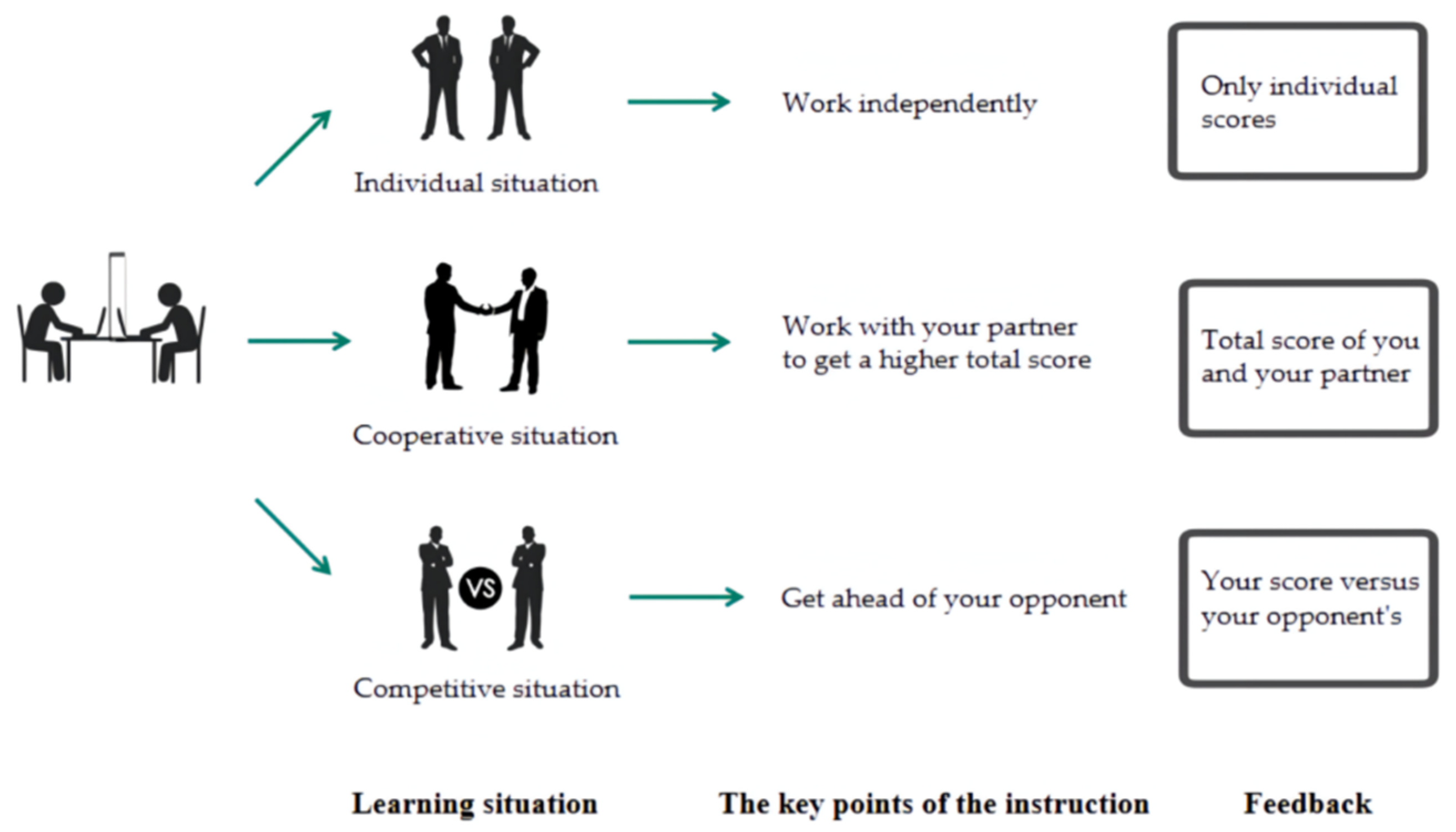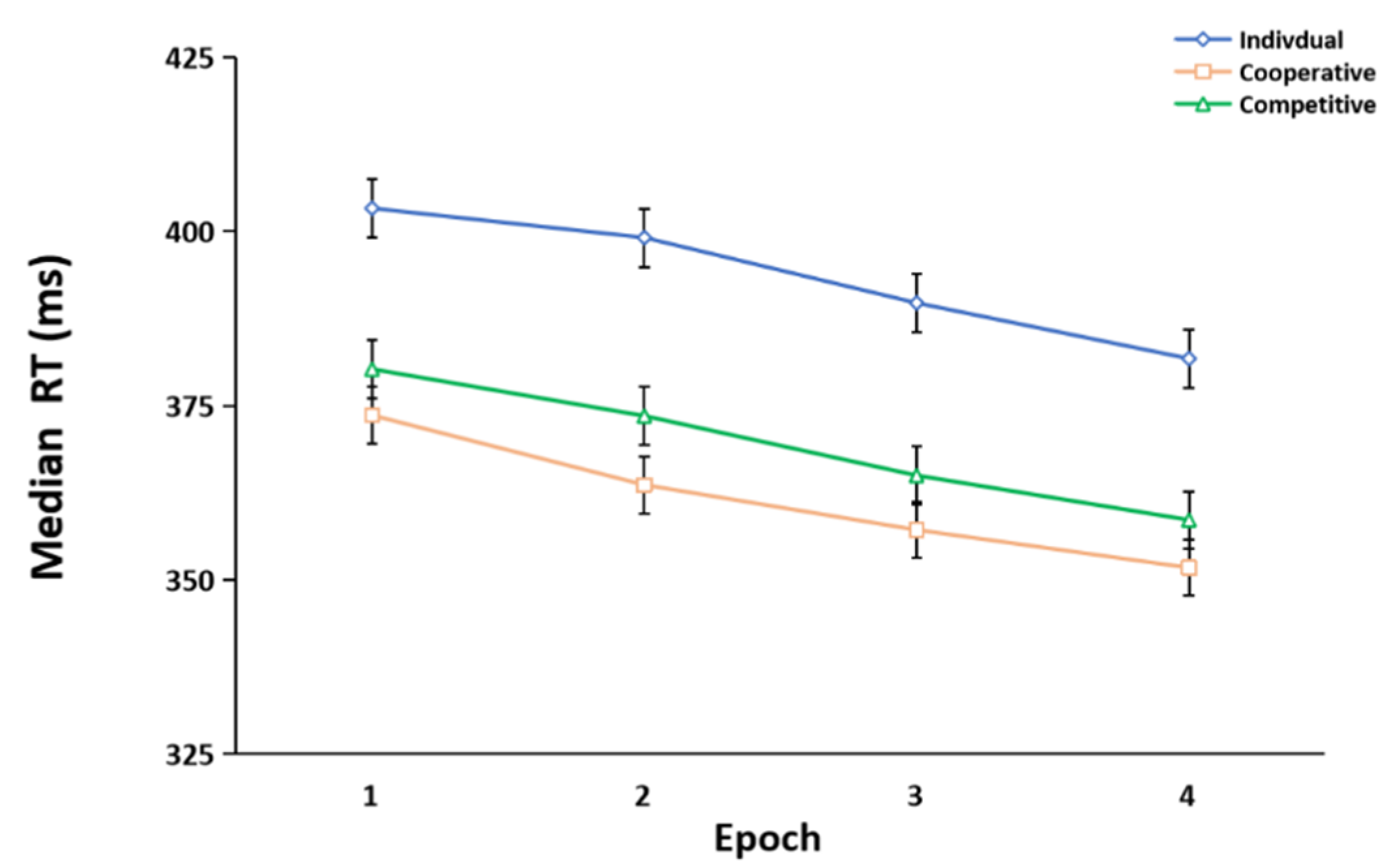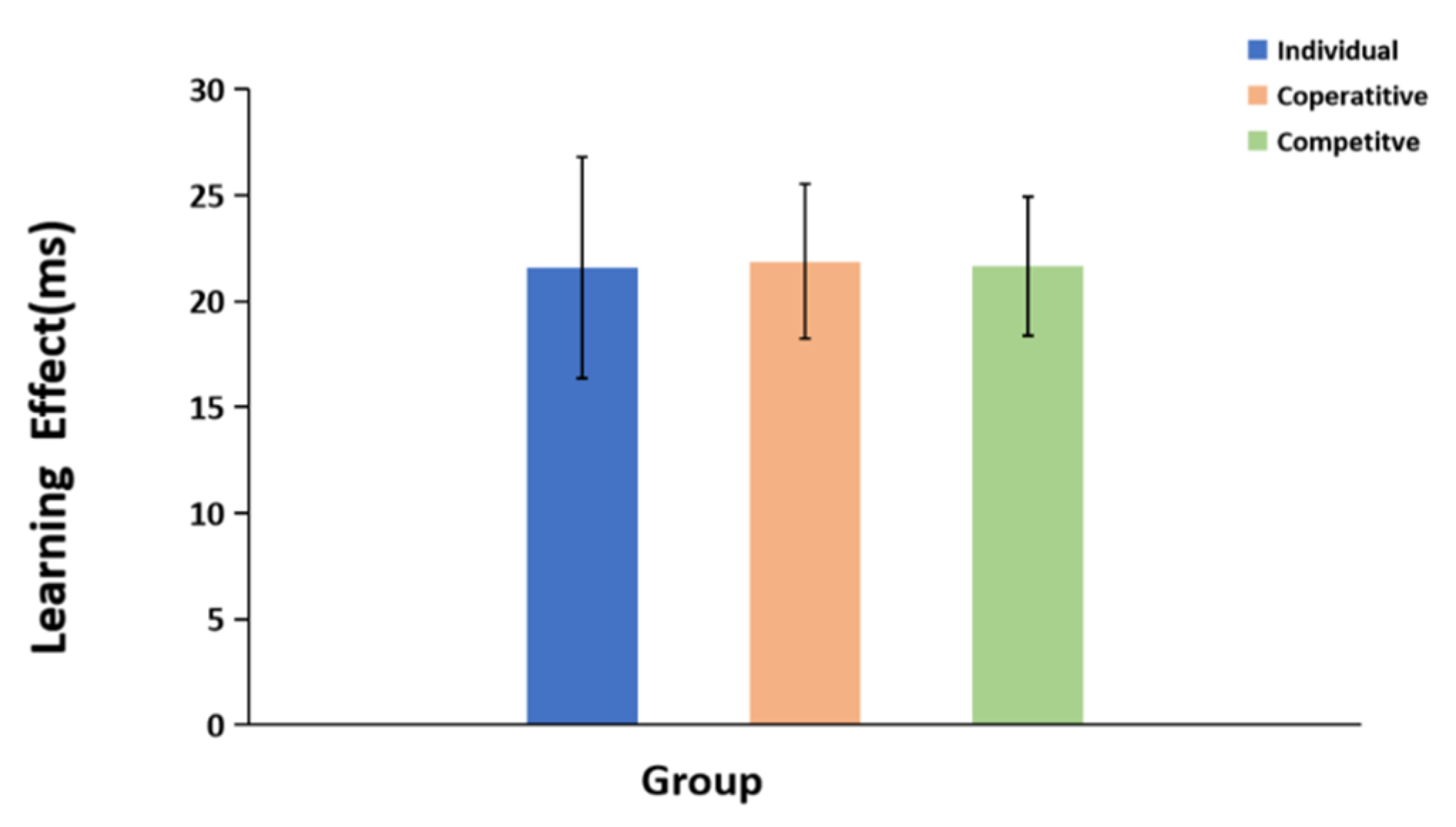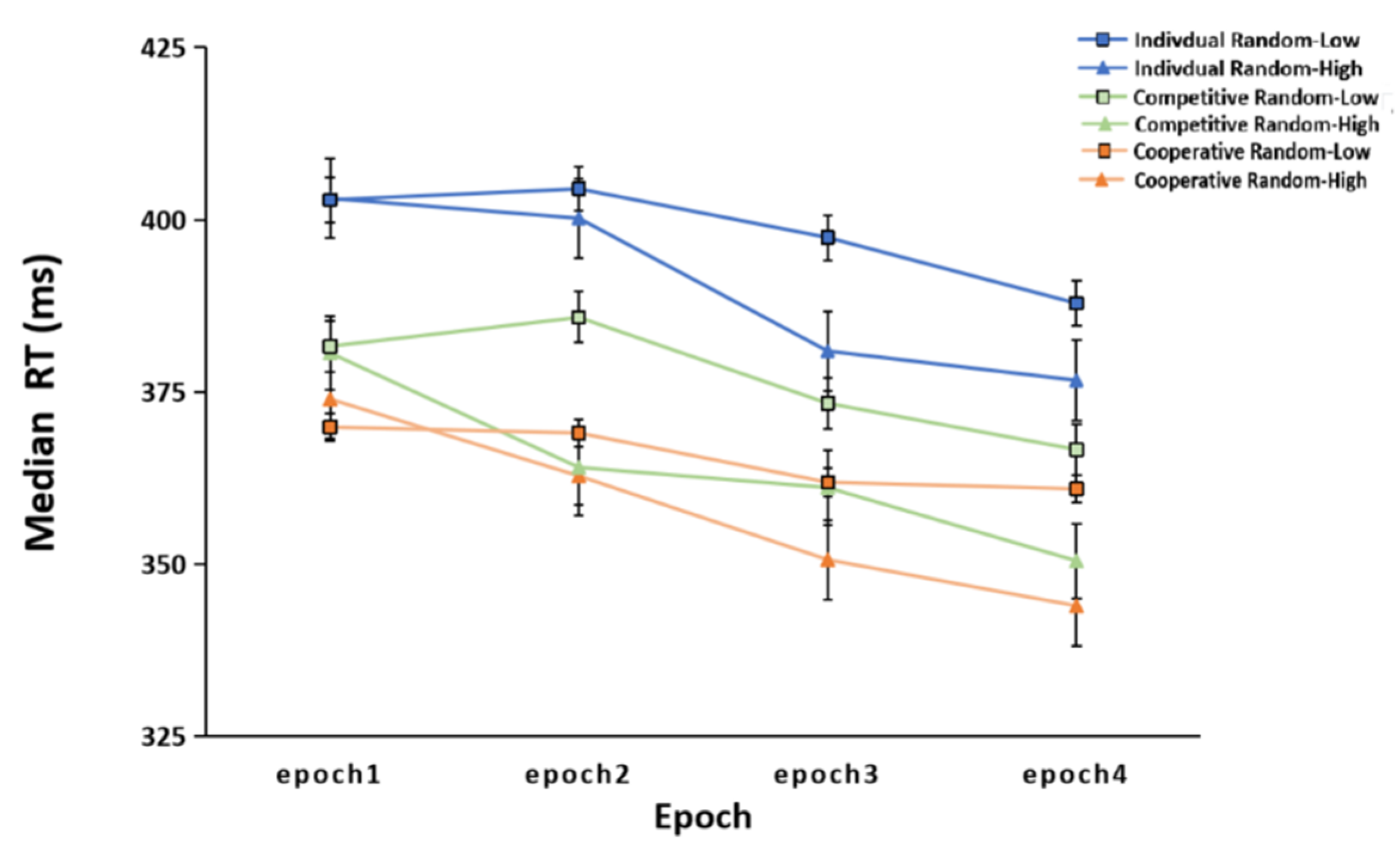The Effects of Cooperative and Competitive Situations on Statistical Learning
Abstract
:1. Introduction
2. Materials and Methods
2.1. Participants
2.2. Design
2.3. ASRT Task
2.4. Procedure
2.5. Statistical Analysis
3. Results
3.1. General Skill Learning
3.2. Statistical Learning
4. Discussion
5. Conclusions
Supplementary Materials
Author Contributions
Funding
Institutional Review Board Statement
Informed Consent Statement
Data Availability Statement
Conflicts of Interest
References
- Johnson, D.W.; Johnson, R.T. Intellectual Legacy: Cooperation and Competition. In Conflict, Interdependence, and Justice; Springer: New York, NY, USA, 2011; pp. 41–63. [Google Scholar] [CrossRef]
- Johnson, D.W.; Johnson, R.T. Cooperative Learning: The Foundation for Active Learning. In Active Learning—Beyond the Future; IntechOpen: London, UK, 2019. [Google Scholar] [CrossRef] [Green Version]
- Cardellini, L. Problem Solving Through Cooperative Learning in the Chemistry Classroom. In Learning with Understanding in the Chemistry Classroom; Springer: Amsterdam, The Netherlands, 2014; pp. 149–163. [Google Scholar] [CrossRef]
- Corell, A.; Regueras, L.M.; Verdú, E.; Verdú, M.J.; de Castro, J.P. Effects of Competitive Learning Tools on Medical Students: A Case Study. PLoS ONE 2018, 13, e0194096. [Google Scholar] [CrossRef] [PubMed]
- Quesque, F.; Mignon, A.; Coello, Y. Cooperative and competitive contexts do not modify the effect of social intention on motor action—ScienceDirect. Conscious. Cogn. 2017, 56, 91–99. [Google Scholar] [CrossRef] [PubMed]
- Huashuo, L.; Chenying, Z.; Fei, W.; Dan, Z. Inter-Brain Amplitude Correlation Differentiates Cooperation from Competition in a Motion-Sensing Sports Game. Soc. Cogn. Affect. Neurosci. 2021, 16, 552–564. [Google Scholar] [CrossRef]
- Balconi, M.; Crivelli, D.; Vanutelli, M.E. Why to cooperate is better than to compete: Brain and personality components. BMC Neurosci. 2017, 18, 68. [Google Scholar] [CrossRef] [Green Version]
- Lin, C.H.; Huang, S.H.; Shih, J.L.; Covaci, A.; Ghinea, G. Game-Based Learning Effectiveness and Motivation Study between Competitive and Cooperative Modes. In Proceedings of the IEEE 17th International Conference on Advanced Learning Technologies, ICALT 2017, Timisoara, Romania, 3–7 July 2017; pp. 123–127. [Google Scholar] [CrossRef]
- Webb, N.M.; Troper, J.D.; Fall, R. Constructive Activity and Learning in Collaborative Small Groups. J. Educ. Psychol. 1995, 87, 406–423. [Google Scholar] [CrossRef]
- Van Eck, R.; Dempsey, J. The Effect of Competition and Contextualized Advisement on the Transfer of Mathematics Skills in a Computer-Based Instructional Simulation Game. Educ. Technol. Res. Dev. 2002, 50, 23–41. [Google Scholar] [CrossRef]
- Zakaria, E.; Chin, L.C.; Daud, Y. The Effects of Cooperative Learning on Students’ Mathematics Achievement and Attitude towards Mathematics. J. Soc. Sci. 2010, 6, 272–275. [Google Scholar] [CrossRef] [Green Version]
- Zakaria, E.; Solfitri, T.; Daud, Y.; Abidin, Z.Z. Effect of Cooperative Learning on Secondary School Students’ Mathematics Achievement. Creat. Educ. 2013, 4, 98–100. [Google Scholar] [CrossRef] [Green Version]
- Dindar, M.; Ren, L.; Järvenoja, H. An Experimental Study on the Effects of Gamified Cooperation and Competition on English Vocabulary Learning. Br. J. Educ. Technol. 2021, 52, 142–159. [Google Scholar] [CrossRef]
- Johnson, D.W.; Johnson, R.T. An Educational Psychology Success Story: Social Interdependence Theory and Cooperative Learning. Educ. Res. 2009, 38, 365–379. [Google Scholar] [CrossRef] [Green Version]
- Johnson, D.W.; Johnson, R.T. Cooperative Learning Methods: A Meta-Analysis. J. Res. Educ. 2002, 12, 95–105. [Google Scholar]
- Quentin, R.; Fanuel, L.; Kiss, M.; Vernet, M.; Vékony, T.; Janacsek, K.; Cohen, L.G.; Nemeth, D. Statistical Learning Occurs during Practice While High-Order Rule Learning during Rest Period. NPJ Sci. Learn. 2021, 6, 14. [Google Scholar] [CrossRef] [PubMed]
- Horváth, K.; Török, C.; Pesthy, O.; Nemeth, D.; Janacsek, K. Intention to Learn Differentially Affects Subprocesses of Procedural Learning and Consolidation: Evidence from a Probabilistic Sequence Learning Task. bioRxiv 2018. [Google Scholar] [CrossRef]
- Tóth-Fáber, E.; Tárnok, Z.; Janacsek, K.; Kóbor, A.; Nagy, P.; Farkas, B.C.; Oláh, S.; Merkl, D.; Hegedűs, O.; Nemeth, D.; et al. Dissociation between Two Aspects of Procedural Learning in Tourette Syndrome: Enhanced Statistical and Impaired Sequence Learning. Child Neuropsychol. 2021, 27, 799–821. [Google Scholar] [CrossRef]
- Saffran, J.R.; Aslin, R.N.; Newport, E.L. Statistical Learning by 8-Month-Old Infants. Science 1996, 274, 1926–1928. [Google Scholar] [CrossRef] [Green Version]
- Frost, R.; Armstrong, B.C.; Siegelman, N.; Christiansen, M.H. Domain Generality versus Modality Specificity: The Paradox of Statistical Learning. Trends Cogn. Sci. 2015, 19, 117–125. [Google Scholar] [CrossRef] [Green Version]
- Vékony, T.; Marossy, H.; Must, A.; Vécsei, L.; Janacsek, K.; Nemeth, D. Speed or Accuracy Instructions During Skill Learning Do Not Affect the Acquired Knowledge. Cereb. Cortex Commun. 2020, 1, tgaa041. [Google Scholar] [CrossRef]
- Bogaerts, L.; Frost, R.; Christiansen, M.H. Integrating Statistical Learning into Cognitive Science. J. Mem. Lang. 2020, 115, 104167. [Google Scholar] [CrossRef]
- Tóth-Fáber, E.; Janacsek, K.; Szőllősi, Á.; Kéri, S.; Nemeth, D. Regularity Detection under Stress: Faster Extraction of Probability-Based Regularities. PLoS ONE 2021, 16, e0253123. [Google Scholar] [CrossRef]
- Karimian, F.; Kazemi, Y.; Najimi, A. Statistical Learning in Late Talkers and Normal Peers. Adv. Biomed. Res. 2020, 9, 22. [Google Scholar] [CrossRef]
- Kobor, A.; Janacsek, K.; Takacs, A.; Nemeth, D. Statistical Learning Leads to Persistent Memory: Evidence for One-Year Consolidation. Sci. Rep. 2017, 7, 760. [Google Scholar] [CrossRef] [PubMed] [Green Version]
- Teinonen, T.; Fellman, V.; Näätänen, R.; Alku, P.; Huotilainen, M. Statistical Language Learning in Neonates Revealed by Event-Related Brain Potentials. BMC Neurosci. 2009, 10, 21. [Google Scholar] [CrossRef] [PubMed] [Green Version]
- Turk-Browne, N.B.; Scholl, B.J.; Johnson, M.K.; Chun, M.M. Implicit Perceptual Anticipation Triggered by Statistical Learning. J. Neurosci. 2010, 30, 11177–11187. [Google Scholar] [CrossRef] [PubMed] [Green Version]
- Obeid, R.; Brooks, P.J.; Powers, K.L.; Gillespie-Lynch, K.; Lum, J.A.G. Statistical Learning in Specific Language Impairment and Autism Spectrum Disorder: A Meta-Analysis. Front. Psychol. 2016, 7, 1245. [Google Scholar] [CrossRef]
- Deocampo, J.A.; Smith, G.N.L.; Kronenberger, W.G.; Pisoni, D.B.; Conway, C.M. The Role of Statistical Learning in Understanding and Treating Spoken Language Outcomes in Deaf Children with Cochlear Implants. Lang. Speech. Hear. Serv. Sch. 2018, 49, 723–739. [Google Scholar] [CrossRef]
- Erickson, L.C.; Thiessen, E.D. Statistical Learning of Language: Theory, Validity, and Predictions of a Statistical Learning Account of Language Acquisition. Dev. Rev. 2015, 37, 66–108. [Google Scholar] [CrossRef] [Green Version]
- Conway, C.M. How Does the Brain Learn Environmental Structure? Ten Core Principles for Understanding the Neurocognitive Mechanisms of Statistical Learning. Neurosci. Biobehav. Rev. 2020, 112, 279–299. [Google Scholar] [CrossRef]
- Parks, K.M.A.; Griffith, L.A.; Armstrong, N.B.; Stevenson, R.A. Statistical Learning and Social Competency: The Mediating Role of Language. Sci. Rep. 2020, 10, 3968. [Google Scholar] [CrossRef]
- Monroy, C.D.; Meyer, M.; Schröer, L.; Gerson, S.A.; Hunnius, S. The Infant Motor System Predicts Actions Based on Visual Statistical Learning. Neuroimage 2019, 185, 947–954. [Google Scholar] [CrossRef]
- Aslin, R.N.; Newport, E.L. Statistical Learning: From Acquiring Specific Items to Forming General Rules. Curr. Dir. Psychol. Sci. 2012, 21, 170–176. [Google Scholar] [CrossRef]
- Aslin, R.N. Statistical Learning: A Powerful Mechanism That Operates by Mere Exposure. Wiley Interdiscip. Rev. Cogn. Sci. 2017, 8, e1373. [Google Scholar] [CrossRef] [PubMed] [Green Version]
- Park, J.; Yoon, H.D.; Yoo, T.; Shin, M.; Jeon, H.A. Potential and Efficiency of Statistical Learning Closely Intertwined with Individuals’ Executive Functions: A Mathematical Modeling Study. Sci. Rep. 2020, 10, 18843. [Google Scholar] [CrossRef]
- Howard, J.H.; Howard, D.V. Age Differences in Implicit Learning of Higher Order Dependencies in Serial Patterns. Psychol. Aging 1997, 12, 634–656. [Google Scholar] [CrossRef] [PubMed]
- Song, S.; Howard, J.H.; Howard, D.V. Sleep Does Not Benefit Probabilistic Motor Sequence Learning. J. Neurosci. 2007, 27, 12475–12483. [Google Scholar] [CrossRef] [PubMed]
- Nemeth, D.; Janacsek, K.; Fiser, J. Age-Dependent and Coordinated Shift in Performance between Implicit and Explicit Skill Learning. Front. Comput. Neurosci. 2013, 7, 147. [Google Scholar] [CrossRef] [PubMed] [Green Version]
- Kóbor, A.; Takács, Á.; Kardos, Z.; Janacsek, K.; Horváth, K.; Csépe, V.; Nemeth, D. ERPs Differentiate the Sensitivity to Statistical Probabilities and the Learning of Sequential Structures during Procedural Learning. Biol. Psychol. 2018, 135, 180–193. [Google Scholar] [CrossRef]
- Nemeth, D.; Csábi, E.; Janacsek, K.; Várszegi, M.; Mari, Z. Intact Implicit Probabilistic Sequence Learning in Obstructive Sleep Apnea. J. Sleep Res. 2012, 21, 396–401. [Google Scholar] [CrossRef]
- Janacsek, K.; Ambrus, G.G.; Paulus, W.; Antal, A.; Nemeth, D. Right Hemisphere Advantage in Statistical Learning: Evidence from a Probabilistic Sequence Learning Task. Brain Stimul. 2015, 8, 277–282. [Google Scholar] [CrossRef]
- Tóth, B.; Janacsek, K.; Takács, Á.; Kóbor, A.; Zavecz, Z.; Nemeth, D. Dynamics of EEG Functional Connectivity during Statistical Learning. Neurobiol. Learn. Mem. 2017, 144, 216–229. [Google Scholar] [CrossRef] [Green Version]
- Yu, R.; Hu, P.; Zhang, P. Social Distance and Anonymity Modulate Fairness Consideration: An ERP Study. Sci. Rep. 2015, 5, 13452. [Google Scholar] [CrossRef] [Green Version]
- Wang, Y.; Zhang, Z.; Bai, L.; Lin, C.; Osinsky, R.; Hewig, J. Ingroup/Outgroup Membership Modulates Fairness Consideration: Neural Signatures from ERPs and EEG Oscillations. Sci. Rep. 2017, 7, 39827. [Google Scholar] [CrossRef] [PubMed] [Green Version]
- Nemeth, D.; Janacsek, K.; Londe, Z.; Ullman, M.T.; Howard, D.V.; Howard, J.H. Sleep Has No Critical Role in Implicit Motor Sequence Learning in Young and Old Adults. Exp. Brain Res. 2010, 201, 351–358. [Google Scholar] [CrossRef] [PubMed]
- Brainard, D.H. The Psychophysics Toolbox. Spat. Vis. 1997, 10, 433–436. [Google Scholar] [CrossRef] [PubMed] [Green Version]
- Tóth-Fáber, E.; Janacsek, K.; Szőllősi, Á.; Kéri, S.; Németh, D. Procedural Learning under Stress: Boosted Statistical Learning but Unaffected Sequence Learning. bioRxiv 2020. [Google Scholar] [CrossRef]
- Romano Bergstrom, J.C.; Howard, J.H.; Howard, D.V. Enhanced Implicit Sequence Learning in College-Age Video Game Players and Musicians. Appl. Cogn. Psychol. 2012, 26, 91–96. [Google Scholar] [CrossRef]
- Howard, D.V.; Howard, J.H.; Japikse, K.; DiYanni, C.; Thompson, A.; Somberg, R. Implicit Sequence Learning: Effects of Level of Structure, Adult Age, and Extended Practice. Psychol. Aging 2004, 19, 79–92. [Google Scholar] [CrossRef] [Green Version]
- Janacsek, K.; Borbély-Ipkovich, E.; Nemeth, D.; Gonda, X. How Can the Depressed Mind Extract and Remember Predictive Relationships of the Environment? Evidence from Implicit Probabilistic Sequence Learning. Prog. Neuropsychopharmacol. Biol. Psychiatry 2018, 81, 17–24. [Google Scholar] [CrossRef] [Green Version]
- Unoka, Z.; Vizin, G.; Bjelik, A.; Radics, D.; Nemeth, D.; Janacsek, K. Intact Implicit Statistical Learning in Borderline Personality Disorder. Psychiatry Res. 2017, 255, 373–381. [Google Scholar] [CrossRef] [Green Version]
- Vékony, T.; Török, L.; Pedraza, F.; Schipper, K.; Pleche, C.; Tóth, L.; Janacsek, K.; Nemeth, D. Retrieval of a Well-Established Skill Is Resistant to Distraction: Evidence from an Implicit Probabilistic Sequence Learning Task. PLoS ONE 2020, 15, e0243541. [Google Scholar] [CrossRef]
- Hwang, G.J.; Wu, P.H.; Chen, C.C. An Online Game Approach for Improving Students’ Learning Performance in Web-Based Problem-Solving Activities. Comput. Educ. 2012, 59, 1246–1256. [Google Scholar] [CrossRef]
- Chen, Z.H.; Chen, S.Y. When Educational Agents Meet Surrogate Competition: Impacts of Competitive Educational Agents on Students’ Motivation and Performance. Comput. Educ. 2014, 75, 274–281. [Google Scholar] [CrossRef]






Publisher’s Note: MDPI stays neutral with regard to jurisdictional claims in published maps and institutional affiliations. |
© 2022 by the authors. Licensee MDPI, Basel, Switzerland. This article is an open access article distributed under the terms and conditions of the Creative Commons Attribution (CC BY) license (https://creativecommons.org/licenses/by/4.0/).
Share and Cite
Si, Y.; Chen, X.; Guo, W.; Wang, B. The Effects of Cooperative and Competitive Situations on Statistical Learning. Brain Sci. 2022, 12, 1059. https://doi.org/10.3390/brainsci12081059
Si Y, Chen X, Guo W, Wang B. The Effects of Cooperative and Competitive Situations on Statistical Learning. Brain Sciences. 2022; 12(8):1059. https://doi.org/10.3390/brainsci12081059
Chicago/Turabian StyleSi, Yajie, Xinyu Chen, Wei Guo, and Biye Wang. 2022. "The Effects of Cooperative and Competitive Situations on Statistical Learning" Brain Sciences 12, no. 8: 1059. https://doi.org/10.3390/brainsci12081059
APA StyleSi, Y., Chen, X., Guo, W., & Wang, B. (2022). The Effects of Cooperative and Competitive Situations on Statistical Learning. Brain Sciences, 12(8), 1059. https://doi.org/10.3390/brainsci12081059





